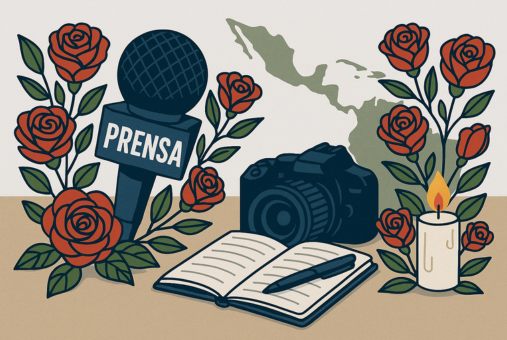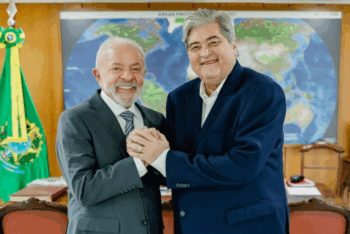
El Centro Knight para el Periodismo en las Américas cerró el año 2025 con broche de oro, consolidando su papel a la vanguardia de los esfuerzos globales para fortalecer el periodismo independiente y de calidad.

La región registró al menos 17 asesinatos, con México como el país más letal. Expertos señalan que la retórica hostil de las autoridades y la impunidad arraigada siguen alimentando los ataques.

Los periodistas latinoamericanos enfrentan ataques pero persisten. Las principales historias del año muestran a reporteros forzados al exilio, resistiendo ataques autoritarios, promoviendo alfabetización mediática y destapando fraudes millonarios.

LJR destaca en esta lista anual 10 proyectos que rastrearon economías ilícitas en la Amazonía, expusieron abusos contra migrantes, contrarrestaron estafas digitales y celebraron el legado de un ícono del rock.
💬 Comente “LJR” para receber o link do artigo completo!
A cúpula climática da ONU deste ano, conhecida como COP30, acontecerá no coração da Amazônia pela primeira vez.
É um marco para a América Latina, mas devido aos altos custos de viagem e hospedagem, além de questões logísticas complexas, muitos repórteres da região estão tendo dificuldades para participar do evento.
A cidade costeira de Belém espera receber 45 mil pessoas, disputando 18 mil camas de hotel normalmente disponíveis. O governo diz que está trabalhando para aumentar a oferta, mas, como resultado, os preços dos hotéis dispararam.
Na semana passada, o Observatório do Clima divulgou nota pública afirmando que a crise de hospedagem na capital paraense "ameaça tornar a COP30 a menos inclusiva da história" e já afasta delegações estaduais e representantes da sociedade civil.
"Os custos estão significativamente maiores", afirmou à LatAm Journalism Review (LJR) Fermín Koop, editor-adjunto para a América Latina do Dialogue Earth e veterano em coberturas de COPs, com 10 conferências no currículo. "Em COPs anteriores, mesmo em cidades com alto custo de vida, geralmente havia uma gama de opções de acomodação a distâncias viáveis. Em Belém, a oferta limitada e a alta demanda elevaram os preços bem além do que muitos jornalistas ou seus veículos conseguem pagar."
Jornalistas ambientais da América Latina estão adotando diferentes estratégias para superar as barreiras financeiras e logísticas para participar. Eles estão encurtando estadias, compartilhando acomodações e buscando apoio financeiro de organizações parceiras para cobrir o evento presencialmente.
Eles temem que a situação em Belém reduza a diversidade de vozes cobrindo a COP30 e compartilhando as perspectivas de suas comunidades... 💬 Comente “LJR” para receber o link do artigo completo!
Por Marta Szpacenkopf

💬 Comente “LJR” para receber o link do artigo completo!
A cúpula climática da ONU deste ano, conhecida como COP30, acontecerá no coração da Amazônia pela primeira vez.
É um marco para a América Latina, mas devido aos altos custos de viagem e hospedagem, além de questões logísticas complexas, muitos repórteres da região estão tendo dificuldades para participar do evento.
A cidade costeira de Belém espera receber 45 mil pessoas, disputando 18 mil camas de hotel normalmente disponíveis. O governo diz que está trabalhando para aumentar a oferta, mas, como resultado, os preços dos hotéis dispararam.
Na semana passada, o Observatório do Clima divulgou nota pública afirmando que a crise de hospedagem na capital paraense "ameaça tornar a COP30 a menos inclusiva da história" e já afasta delegações estaduais e representantes da sociedade civil.
"Os custos estão significativamente maiores", afirmou à LatAm Journalism Review (LJR) Fermín Koop, editor-adjunto para a América Latina do Dialogue Earth e veterano em coberturas de COPs, com 10 conferências no currículo. "Em COPs anteriores, mesmo em cidades com alto custo de vida, geralmente havia uma gama de opções de acomodação a distâncias viáveis. Em Belém, a oferta limitada e a alta demanda elevaram os preços bem além do que muitos jornalistas ou seus veículos conseguem pagar."
Jornalistas ambientais da América Latina estão adotando diferentes estratégias para superar as barreiras financeiras e logísticas para participar. Eles estão encurtando estadias, compartilhando acomodações e buscando apoio financeiro de organizações parceiras para cobrir o evento presencialmente.
Eles temem que a situação em Belém reduza a diversidade de vozes cobrindo a COP30 e compartilhando as perspectivas de suas comunidades... 💬 Comente “LJR” para receber o link do artigo completo!
Por Marta Szpacenkopf
...
💬 Comenta "LJR" y te enviamos el artículo completo.
El sociólogo Eduardo de León es uno de los 23,000 suscriptores del periódico uruguayo @ladiaria
Pero él no solo está leyendo la publicación, sino que está activamente contribuyendo en su contenido.
De León escribe columnas para la diaria y ha sido invitado en dos episodios del proyecto radiofónico “La Mañana de La Diaria”, financiado por los lectores, en el que debate cuestiones políticas en directo con expertos de la comunidad y el presentador Martin Rodríguez.
“A mí me parece que sí que que también ahí están cubriendo un espacio que no existía hasta ahora”, De León a LatAm Journalism Review (LJR). “Un espacio de debate de análisis en profundidad de política pública.”
De León es emblemático del tipo de periodismo que la diaria pretende producir: uno que fomente un sentido de pertenencia entre los lectores, al tiempo que recurre a ellos en busca de conocimiento.
Desde su creación en 2006, la diaria ha crecido con el apoyo de sus suscriptores. Actualmente, el 90% de sus ingresos proviene de suscripciones como la de De León, de acuerdo con el periodista y editor de la diaria Lucas Silva.
La publicación también invita a la comunidad a financiar productos e iniciativas específicas. Recientemente, gracias a los lectores, han surgido un documental y una emisora de radio... 💬 Comenta "LJR" y te enviamos el artículo completo.
Por Marisela Perez Maita
Foto: Collage digital, imágenes de Canva y cortesía de la diaria.

💬 Comenta "LJR" y te enviamos el artículo completo.
El sociólogo Eduardo de León es uno de los 23,000 suscriptores del periódico uruguayo @ladiaria
Pero él no solo está leyendo la publicación, sino que está activamente contribuyendo en su contenido.
De León escribe columnas para la diaria y ha sido invitado en dos episodios del proyecto radiofónico “La Mañana de La Diaria”, financiado por los lectores, en el que debate cuestiones políticas en directo con expertos de la comunidad y el presentador Martin Rodríguez.
“A mí me parece que sí que que también ahí están cubriendo un espacio que no existía hasta ahora”, De León a LatAm Journalism Review (LJR). “Un espacio de debate de análisis en profundidad de política pública.”
De León es emblemático del tipo de periodismo que la diaria pretende producir: uno que fomente un sentido de pertenencia entre los lectores, al tiempo que recurre a ellos en busca de conocimiento.
Desde su creación en 2006, la diaria ha crecido con el apoyo de sus suscriptores. Actualmente, el 90% de sus ingresos proviene de suscripciones como la de De León, de acuerdo con el periodista y editor de la diaria Lucas Silva.
La publicación también invita a la comunidad a financiar productos e iniciativas específicas. Recientemente, gracias a los lectores, han surgido un documental y una emisora de radio... 💬 Comenta "LJR" y te enviamos el artículo completo.
Por Marisela Perez Maita
Foto: Collage digital, imágenes de Canva y cortesía de la diaria.
...
💬 Comenta "LJR" y te enviamos la entrevista completa.
Los asesinatos de la periodista de investigación Regina Martínez y del fotoperiodista Rubén Espinosa, en 2012 y 2015 respectivamente, conmocionaron al gremio periodístico en México y se convirtieron en casos emblemáticos de la violencia contra la prensa y del altísimo riesgo que representa ejercer la profesión en ese país.
Varios años después, ambos crímenes –que permanecen en la impunidad– sirven de inspiración para la película “Cocodrilos”, la ópera prima del director J. Xavier Velasco (@jxaviervelasco), quien, al igual que Martínez y Espinosa, es originario del estado de Veracruz.
El filme es un thriller que aborda desde la ficción el costo de buscar la verdad en un país donde la colusión entre autoridades y crimen organizado es la principal amenaza contra el derecho de la gente a estar informada.
Tras estrenarse mundialmente en el Chicago Latino Film Festival (@chilatinofilm) en abril de este año, “Cocodrilos” inició una ruta por diversos festivales en México. Se espera que llegue a plataformas digitales en la primera mitad de 2026, de acuerdo con su director.
En conversación con LatAm Journalism Review (LJR), Velasco cuenta que su película, además de honrar la memoria de Martínez y Espinosa, es una forma de visibilizar la violencia contra la prensa, que en México corre el riesgo de ser normalizada. También detalla su empeño por retratar con verosimilitud los riesgos del oficio periodístico y resalta la importancia de defender la libertad de prensa frente a amenazas, corrupción e impunidad... 💬 Comenta "LJR" y te enviamos la entrevista completa.
#cocodriloslapelicula #cinemexicano #periodismo #periodista #cineindependiente #cine

💬 Comenta "LJR" y te enviamos la entrevista completa.
Los asesinatos de la periodista de investigación Regina Martínez y del fotoperiodista Rubén Espinosa, en 2012 y 2015 respectivamente, conmocionaron al gremio periodístico en México y se convirtieron en casos emblemáticos de la violencia contra la prensa y del altísimo riesgo que representa ejercer la profesión en ese país.
Varios años después, ambos crímenes –que permanecen en la impunidad– sirven de inspiración para la película “Cocodrilos”, la ópera prima del director J. Xavier Velasco (@jxaviervelasco), quien, al igual que Martínez y Espinosa, es originario del estado de Veracruz.
El filme es un thriller que aborda desde la ficción el costo de buscar la verdad en un país donde la colusión entre autoridades y crimen organizado es la principal amenaza contra el derecho de la gente a estar informada.
Tras estrenarse mundialmente en el Chicago Latino Film Festival (@chilatinofilm) en abril de este año, “Cocodrilos” inició una ruta por diversos festivales en México. Se espera que llegue a plataformas digitales en la primera mitad de 2026, de acuerdo con su director.
En conversación con LatAm Journalism Review (LJR), Velasco cuenta que su película, además de honrar la memoria de Martínez y Espinosa, es una forma de visibilizar la violencia contra la prensa, que en México corre el riesgo de ser normalizada. También detalla su empeño por retratar con verosimilitud los riesgos del oficio periodístico y resalta la importancia de defender la libertad de prensa frente a amenazas, corrupción e impunidad... 💬 Comenta "LJR" y te enviamos la entrevista completa.
#cocodriloslapelicula #cinemexicano #periodismo #periodista #cineindependiente #cine
...
Con la creciente popularidad de los podcasts, los periodistas a menudo se encuentran detrás del micrófono para informar sobre investigaciones o noticias del día.
Pero, en un intento por compartir sus propias historias, algunos están incursionando en estos espacios de audio como el foco de sus reportajes.
“Los periodistas suelen trabajar duro, a menudo a un ritmo frenético, pero no siempre se detienen a reflexionar sobre su profesión, comprender cómo trabajan otros colegas ni reconocer las constantes transformaciones en nuestro oficio”, dijo a LatAm Journalism Review (LJR), el periodista brasileño Rodrigo Alves.
Precisamente hace siete años, Alves creó el podcast “Vida de Jornalista” inicialmente para conocer más sobre la vida de colegas a quienes admiraba.
Como Alves, periodistas y organizaciones interesadas en la libertad de prensa e innovación, han encontrado en el podcast una herramienta ideal para acercarse a sus audiencias, adaptándose a sus hábitos de consumo.
LJR conversó con los creadores de cinco podcasts de la región que abordan las rutinas periodísticas, las amenazas a la libertad de prensa, los recursos legales e incluso cómo las redacciones están incorporando tecnologías en constante evolución.... 💬 Comenta "LJR" y te enviamos el artículo completo.
Por Silvia Higuera
Foto: Prensa Redacciones5g

Con la creciente popularidad de los podcasts, los periodistas a menudo se encuentran detrás del micrófono para informar sobre investigaciones o noticias del día.
Pero, en un intento por compartir sus propias historias, algunos están incursionando en estos espacios de audio como el foco de sus reportajes.
“Los periodistas suelen trabajar duro, a menudo a un ritmo frenético, pero no siempre se detienen a reflexionar sobre su profesión, comprender cómo trabajan otros colegas ni reconocer las constantes transformaciones en nuestro oficio”, dijo a LatAm Journalism Review (LJR), el periodista brasileño Rodrigo Alves.
Precisamente hace siete años, Alves creó el podcast “Vida de Jornalista” inicialmente para conocer más sobre la vida de colegas a quienes admiraba.
Como Alves, periodistas y organizaciones interesadas en la libertad de prensa e innovación, han encontrado en el podcast una herramienta ideal para acercarse a sus audiencias, adaptándose a sus hábitos de consumo.
LJR conversó con los creadores de cinco podcasts de la región que abordan las rutinas periodísticas, las amenazas a la libertad de prensa, los recursos legales e incluso cómo las redacciones están incorporando tecnologías en constante evolución.... 💬 Comenta "LJR" y te enviamos el artículo completo.
Por Silvia Higuera
Foto: Prensa Redacciones5g
...
💬 Comente “LJR” para receber o link do artigo completo!
O Brasil tem uma das maiores taxas de feminicídio da América Latina. Quase 1.500 mulheres foram mortas no Brasil em 2024 por causa de seu gênero, o maior número desde que o feminicídio foi tipificado em 2015
No entanto, jornalistas especializadas em violência contra as mulheres dizem que, embora a imprensa brasileira tenha apresentado avanços na cobertura desses crimes, ainda enfrenta desafios estruturais para abordar adequadamente a violência de gênero.
"Não penso que a mídia não esteja sendo capaz de apresentar o tamanho do problema por meio de números. Creio que a mídia tem falhado mais em mostrar a complexidade que cerca esse tipo de crime, antes e depois do assassinato", disse a jornalista Marisa Sanematsu, diretora de conteúdo do Instituto Patrícia Galvão, à LatAm Journalism Review (LJR).
O Instituto Patrícia Galvão se dedica à defesa dos direitos das mulheres por meio de ações na mídia. Entre 2015 e 2016, monitorou a cobertura de crimes de feminicídio e identificou uma série de problemas. Segundo Sanematsu, embora os assassinatos recebessem grande cobertura em quantidade de matérias, quase não se usava o termo feminicídio, a maioria das reportagens tinha abordagem policial, e as únicas fontes eram boletins de ocorrência e agentes da segurança pública.
“Mesmo focando no caso individual, a cobertura era superficial, pouco investigativa e, além do mais, estereotipada e preconceituosa, frequentemente justificando o autor e responsabilizando a vítima”, disse Sanematsu. “Os textos limitavam-se ao crime e não havia indicação de portas de saída para a situação de violência, como serviços de acolhimento e canais de denúncia.”
De lá pra cá, Sanematsu diz que há um nítido avanço na cobertura, especialmente por parte dos veículos da “chamada grande imprensa”, mas ainda existem vários exemplos de matérias que desinformam e espetacularizam o crime de feminicídio... 💬 Comente “LJR” para receber o link do artigo completo!
Por Por Marta Szpacenkopf

💬 Comente “LJR” para receber o link do artigo completo!
O Brasil tem uma das maiores taxas de feminicídio da América Latina. Quase 1.500 mulheres foram mortas no Brasil em 2024 por causa de seu gênero, o maior número desde que o feminicídio foi tipificado em 2015
No entanto, jornalistas especializadas em violência contra as mulheres dizem que, embora a imprensa brasileira tenha apresentado avanços na cobertura desses crimes, ainda enfrenta desafios estruturais para abordar adequadamente a violência de gênero.
"Não penso que a mídia não esteja sendo capaz de apresentar o tamanho do problema por meio de números. Creio que a mídia tem falhado mais em mostrar a complexidade que cerca esse tipo de crime, antes e depois do assassinato", disse a jornalista Marisa Sanematsu, diretora de conteúdo do Instituto Patrícia Galvão, à LatAm Journalism Review (LJR).
O Instituto Patrícia Galvão se dedica à defesa dos direitos das mulheres por meio de ações na mídia. Entre 2015 e 2016, monitorou a cobertura de crimes de feminicídio e identificou uma série de problemas. Segundo Sanematsu, embora os assassinatos recebessem grande cobertura em quantidade de matérias, quase não se usava o termo feminicídio, a maioria das reportagens tinha abordagem policial, e as únicas fontes eram boletins de ocorrência e agentes da segurança pública.
“Mesmo focando no caso individual, a cobertura era superficial, pouco investigativa e, além do mais, estereotipada e preconceituosa, frequentemente justificando o autor e responsabilizando a vítima”, disse Sanematsu. “Os textos limitavam-se ao crime e não havia indicação de portas de saída para a situação de violência, como serviços de acolhimento e canais de denúncia.”
De lá pra cá, Sanematsu diz que há um nítido avanço na cobertura, especialmente por parte dos veículos da “chamada grande imprensa”, mas ainda existem vários exemplos de matérias que desinformam e espetacularizam o crime de feminicídio... 💬 Comente “LJR” para receber o link do artigo completo!
Por Por Marta Szpacenkopf
...
💬 Comenta "LJR" para recibir el artículo completo.
A las 4:00 de la mañana, mientras su ciudad aún duerme, Johnny Lucas ya está despierto. Se prepara para llegar a la emisora donde colabora en un noticiero de 5:00 a 8:00 am. Para entonces, su jornada apenas ha comenzado. El resto del día se dedica a reportar y publicar en su propio medio Punto de Vista Manabí.
Lucas repite la rutina de lunes a sábado. Y el domingo, en lugar de descansar, madruga de nuevo para atender un puesto de flores frente al Cementerio General de Manta, ciudad pesquera de la costa ecuatoriana. Lo que comenzó como apoyo a una tradición familiar hoy representa parte de su supervivencia frente a la precariedad del periodismo en Ecuador.
Su caso es similar al de muchos periodistas ecuatorianos que ejercen sin un sueldo digno ni seguridad social, de acuerdo con un informe de este año de la organización Periodistas Sin Cadenas. Para mantenerse, muchos comunicadores ecuatorianos deben combinar sus tareas informativas con trabajos paralelos.
“Lo más difícil es levantarse en horas de la madrugada de lunes a sábado, y el día domingo lo mismo”, dijo Lucas a LatAm Journalism Review (LJR). “No hay un descanso normal”... 💬 Comenta "LJR" para recibir el artículo completo.

💬 Comenta "LJR" para recibir el artículo completo.
A las 4:00 de la mañana, mientras su ciudad aún duerme, Johnny Lucas ya está despierto. Se prepara para llegar a la emisora donde colabora en un noticiero de 5:00 a 8:00 am. Para entonces, su jornada apenas ha comenzado. El resto del día se dedica a reportar y publicar en su propio medio Punto de Vista Manabí.
Lucas repite la rutina de lunes a sábado. Y el domingo, en lugar de descansar, madruga de nuevo para atender un puesto de flores frente al Cementerio General de Manta, ciudad pesquera de la costa ecuatoriana. Lo que comenzó como apoyo a una tradición familiar hoy representa parte de su supervivencia frente a la precariedad del periodismo en Ecuador.
Su caso es similar al de muchos periodistas ecuatorianos que ejercen sin un sueldo digno ni seguridad social, de acuerdo con un informe de este año de la organización Periodistas Sin Cadenas. Para mantenerse, muchos comunicadores ecuatorianos deben combinar sus tareas informativas con trabajos paralelos.
“Lo más difícil es levantarse en horas de la madrugada de lunes a sábado, y el día domingo lo mismo”, dijo Lucas a LatAm Journalism Review (LJR). “No hay un descanso normal”... 💬 Comenta "LJR" para recibir el artículo completo.
...
📢 Ya están abiertas las inscripciones para participar en la Cumbre Global sobre Desinformación 2025, que se realizará los días 17 y 18 de septiembre @cumbredesinfo
💻 100 % virtual y gratuita
🇪🇸 🇺🇸 🇧🇷 Con interpretación simultánea en español, inglés y portugués
🌍 La Cumbre reúne a periodistas, tecnólogos, investigadores y educadores de todo el mundo
🧠 En una agenda sobre:
-los desafíos de la desinformación
-el impacto de la inteligencia artificial
-y el futuro del periodismo
💬 Comenta “cumbre” y te enviamos el link para que te registres GRATIS

📢 Ya están abiertas las inscripciones para participar en la Cumbre Global sobre Desinformación 2025, que se realizará los días 17 y 18 de septiembre @cumbredesinfo
💻 100 % virtual y gratuita
🇪🇸 🇺🇸 🇧🇷 Con interpretación simultánea en español, inglés y portugués
🌍 La Cumbre reúne a periodistas, tecnólogos, investigadores y educadores de todo el mundo
🧠 En una agenda sobre:
-los desafíos de la desinformación
-el impacto de la inteligencia artificial
-y el futuro del periodismo
💬 Comenta “cumbre” y te enviamos el link para que te registres GRATIS
...
💬 Comente “LJR” para receber o link do artigo completo!
O Projeto Comprova (@comprova), iniciativa colaborativa de checagem de fatos no Brasil, abandonou as etiquetas "falso", "enganoso", "sátira" e "comprovado" em suas checagens e passou a adotar uma abordagem mais ampla no combate à desinformação.
José Antonio Lima, editor assistente do projeto, disse que a mudança foi motivada pelo entendimento de que a abordagem anterior focava demais no conteúdo em si e negligenciava outros componentes essenciais da desinformação, como sua origem e o que a torna crível para tantas pessoas.
“Percebemos que não basta fazermos uma mera refutação factual das alegações”, disse o jornalista à LatAm Journalism Review (LJR). “As verificações agora investigam não apenas as evidências e alegações das publicações virais, mas também quem são os criadores desses materiais e seus interesses, além das táticas utilizadas para persuadir as pessoas e levá-las a acreditar no que foi publicado. A ideia geral é tornar o conteúdo mais palatável com o intuito de contribuir com o debate público, permitindo que as pessoas tomem suas decisões, independentemente de sua coloração partidária ou ideológica, com base em fatos verdadeiros.”
Além disso, Lima disse que com o fim do uso das etiquetas de classificação dos conteúdos, a expectativa é que ao menos uma parte do público mais afetado pela desinformação passe a se engajar com conteúdos que trazem informações verdadeiras.
“As etiquetas acabavam funcionando como um obstáculo ou uma barreira à conexão entre a verificação e o público”, disse ele à LJR. “Paramos de usá-las justamente após concluirmos que as pessoas têm uma aversão aos conteúdos que vão de encontro a sua visão de mundo.”
As mudanças, implementadas definitivamente após quatro meses de testes, representam uma reformulação metodológica na iniciativa, que foi lançada em 2018 e hoje reúne jornalistas de 42 veículos de comunicação de diversas partes do Brasil que trabalham de forma colaborativa... 💬 Comente “LJR” para receber o link do artigo completo!
Por Marta Szpacenkopf

💬 Comente “LJR” para receber o link do artigo completo!
O Projeto Comprova (@comprova), iniciativa colaborativa de checagem de fatos no Brasil, abandonou as etiquetas "falso", "enganoso", "sátira" e "comprovado" em suas checagens e passou a adotar uma abordagem mais ampla no combate à desinformação.
José Antonio Lima, editor assistente do projeto, disse que a mudança foi motivada pelo entendimento de que a abordagem anterior focava demais no conteúdo em si e negligenciava outros componentes essenciais da desinformação, como sua origem e o que a torna crível para tantas pessoas.
“Percebemos que não basta fazermos uma mera refutação factual das alegações”, disse o jornalista à LatAm Journalism Review (LJR). “As verificações agora investigam não apenas as evidências e alegações das publicações virais, mas também quem são os criadores desses materiais e seus interesses, além das táticas utilizadas para persuadir as pessoas e levá-las a acreditar no que foi publicado. A ideia geral é tornar o conteúdo mais palatável com o intuito de contribuir com o debate público, permitindo que as pessoas tomem suas decisões, independentemente de sua coloração partidária ou ideológica, com base em fatos verdadeiros.”
Além disso, Lima disse que com o fim do uso das etiquetas de classificação dos conteúdos, a expectativa é que ao menos uma parte do público mais afetado pela desinformação passe a se engajar com conteúdos que trazem informações verdadeiras.
“As etiquetas acabavam funcionando como um obstáculo ou uma barreira à conexão entre a verificação e o público”, disse ele à LJR. “Paramos de usá-las justamente após concluirmos que as pessoas têm uma aversão aos conteúdos que vão de encontro a sua visão de mundo.”
As mudanças, implementadas definitivamente após quatro meses de testes, representam uma reformulação metodológica na iniciativa, que foi lançada em 2018 e hoje reúne jornalistas de 42 veículos de comunicação de diversas partes do Brasil que trabalham de forma colaborativa... 💬 Comente “LJR” para receber o link do artigo completo!
Por Marta Szpacenkopf
...
Nuestros boletines se envían semanalmente por correo electrónico.
Únase a miles de suscriptores que reciben la newsletter de LatAm Journalism Review todos los jueves.






